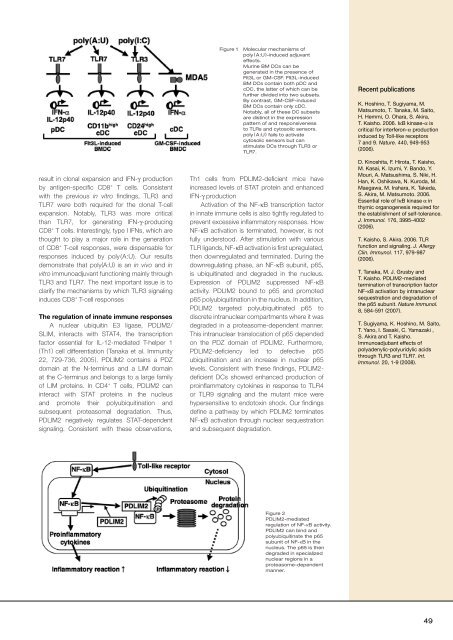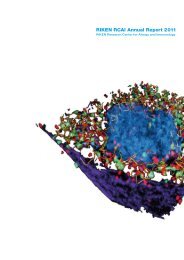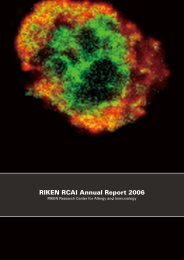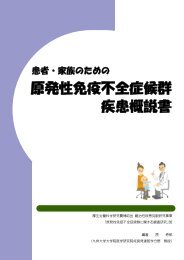in vivo
in vivo
in vivo
Create successful ePaper yourself
Turn your PDF publications into a flip-book with our unique Google optimized e-Paper software.
esult <strong>in</strong> clonal expansion and IFN-γ production<br />
by antigen-specific CD8 + T cells. Consistent<br />
with the previous <strong>in</strong> vitro f<strong>in</strong>d<strong>in</strong>gs, TLR3 and<br />
TLR7 were both required for the clonal T-cell<br />
expansion. Notably, TLR3 was more critical<br />
than TLR7, for generat<strong>in</strong>g IFN-γ-produc<strong>in</strong>g<br />
CD8 + T cells. Interest<strong>in</strong>gly, type I IFNs, which are<br />
thought to play a major role <strong>in</strong> the generation<br />
of CD8 + T-cell responses, were dispensable for<br />
responses <strong>in</strong>duced by poly(A:U). Our results<br />
demonstrate that poly(A:U) is an <strong>in</strong> <strong>vivo</strong> and <strong>in</strong><br />
vitro immunoadjuvant function<strong>in</strong>g ma<strong>in</strong>ly through<br />
TLR3 and TLR7. The next important issue is to<br />
clarify the mechanisms by which TLR3 signal<strong>in</strong>g<br />
<strong>in</strong>duces CD8 + T-cell responses<br />
The regulation of <strong>in</strong>nate immune responses<br />
A nuclear ubiquit<strong>in</strong> E3 ligase, PDLIM2/<br />
SLIM, <strong>in</strong>teracts with STAT4, the transcription<br />
factor essential for IL-12-mediated T-helper 1<br />
(Th1) cell differentiation (Tanaka et al. Immunity<br />
22, 729-736, 2005). PDLIM2 conta<strong>in</strong>s a PDZ<br />
doma<strong>in</strong> at the N-term<strong>in</strong>us and a LIM doma<strong>in</strong><br />
at the C-term<strong>in</strong>us and belongs to a large family<br />
of LIM prote<strong>in</strong>s. In CD4 + T cells, PDLIM2 can<br />
<strong>in</strong>teract with STAT prote<strong>in</strong>s <strong>in</strong> the nucleus<br />
and promote their polyubiquit<strong>in</strong>ation and<br />
subsequent proteasomal degradation. Thus,<br />
PDLIM2 negatively regulates STAT-dependent<br />
signal<strong>in</strong>g. Consistent with these observations,<br />
Figure 1<br />
Molecular mechanisms of<br />
poly(A:U)-<strong>in</strong>duced adjuvant<br />
effects.<br />
Mur<strong>in</strong>e BM DCs can be<br />
generated <strong>in</strong> the presence of<br />
Flt3L or GM-CSF. Flt3L-<strong>in</strong>duced<br />
BM DCs conta<strong>in</strong> both pDC and<br />
cDC, the latter of which can be<br />
further divided <strong>in</strong>to two subsets.<br />
By contrast, GM-CSF-<strong>in</strong>duced<br />
BM DCs conta<strong>in</strong> only cDC.<br />
Notably, all of these DC subsets<br />
are dist<strong>in</strong>ct <strong>in</strong> the expression<br />
pattern of and responsiveness<br />
to TLRs and cytosolic sensors.<br />
poly(A:U) fails to activate<br />
cytosolic sensors but can<br />
stimulate DCs through TLR3 or<br />
TLR7.<br />
Th1 cells from PDLIM2-deficient mice have<br />
<strong>in</strong>creased levels of STAT prote<strong>in</strong> and enhanced<br />
IFN-γ production<br />
Activation of the NF-κB transcription factor<br />
<strong>in</strong> <strong>in</strong>nate immune cells is also tightly regulated to<br />
prevent excessive <strong>in</strong>flammatory responses. How<br />
NF-κB activation is term<strong>in</strong>ated, however, is not<br />
fully understood. After stimulation with various<br />
TLR ligands, NF-κB activation is first upregulated,<br />
then downregulated and term<strong>in</strong>ated. Dur<strong>in</strong>g the<br />
downregulat<strong>in</strong>g phase, an NF-kB subunit, p65,<br />
is ubiquit<strong>in</strong>ated and degraded <strong>in</strong> the nucleus.<br />
Expression of PDLIM2 suppressed NF-κB<br />
activity. PDLIM2 bound to p65 and promoted<br />
p65 polyubiquit<strong>in</strong>ation <strong>in</strong> the nucleus. In addition,<br />
PDLIM2 targeted polyubiquit<strong>in</strong>ated p65 to<br />
discrete <strong>in</strong>tranuclear compartments where it was<br />
degraded <strong>in</strong> a proteasome-dependent manner.<br />
This <strong>in</strong>tranuclear translocation of p65 depended<br />
on the PDZ doma<strong>in</strong> of PDLIM2. Furthermore,<br />
PDLIM2-deficiency led to defective p65<br />
ubiquit<strong>in</strong>ation and an <strong>in</strong>crease <strong>in</strong> nuclear p65<br />
levels. Consistent with these f<strong>in</strong>d<strong>in</strong>gs, PDLIM2-<br />
deficient DCs showed enhanced production of<br />
pro<strong>in</strong>flammatory cytok<strong>in</strong>es <strong>in</strong> response to TLR4<br />
or TLR9 signal<strong>in</strong>g and the mutant mice were<br />
hypersensitive to endotox<strong>in</strong> shock. Our f<strong>in</strong>d<strong>in</strong>gs<br />
def<strong>in</strong>e a pathway by which PDLIM2 term<strong>in</strong>ates<br />
NF-κB activation through nuclear sequestration<br />
and subsequent degradation.<br />
Recent publications<br />
K. Hosh<strong>in</strong>o, T. Sugiyama, M.<br />
Matsumoto, T. Tanaka, M. Saito,<br />
H. Hemmi, O. Ohara, S. Akira,<br />
T. Kaisho. 2006. IκB k<strong>in</strong>ase-α is<br />
critical for <strong>in</strong>terferon-α production<br />
<strong>in</strong>duced by Toll-like receptors<br />
7 and 9. Nature. 440, 949-953<br />
(2006).<br />
D. K<strong>in</strong>oshita, F. Hirota, T. Kaisho,<br />
M. Kasai, K. Izumi, Y. Bando, Y.<br />
Mouri, A. Matsushima, S. Niki, H.<br />
Han, K. Oshikawa, N. Kuroda, M.<br />
Maegawa, M. Irahara, K. Takeda,<br />
S. Akira, M. Matsumoto. 2006.<br />
Essential role of IκB k<strong>in</strong>ase α <strong>in</strong><br />
thymic organogenesis required for<br />
the establishment of self-tolerance.<br />
J. Immunol. 176, 3995-4002<br />
(2006).<br />
T. Kaisho, S. Akira. 2006. TLR<br />
function and signal<strong>in</strong>g. J. Allergy<br />
Cl<strong>in</strong>. Immunol. 117, 979-987<br />
(2006).<br />
T. Tanaka, M. J. Grusby and<br />
T. Kaisho. PDLIM2-mediated<br />
term<strong>in</strong>ation of transcription factor<br />
NF-κB activation by <strong>in</strong>tranuclear<br />
sequestration and degradation of<br />
the p65 subunit. Nature Immunol.<br />
8, 584-591 (2007).<br />
T. Sugiyama, K. Hosh<strong>in</strong>o, M. Saito,<br />
T. Yano, I. Sasaki, C. Yamazaki ,<br />
S. Akira and T. Kaisho.<br />
Immunoadjubant effects of<br />
polyadenylic-polyuridylic acids<br />
through TLR3 and TLR7. Int.<br />
Immunol. 20, 1-9 (2008).<br />
Figure 2<br />
PDLIM2-mediated<br />
regulation of NF-κB activity.<br />
PDLIM2 can b<strong>in</strong>d and<br />
polyubiquit<strong>in</strong>ate the p65<br />
subunit of NF-κB <strong>in</strong> the<br />
nucleus. The p65 is then<br />
degraded <strong>in</strong> specialized<br />
nuclear regions <strong>in</strong> a<br />
proteasome-dependent<br />
manner.<br />
49





